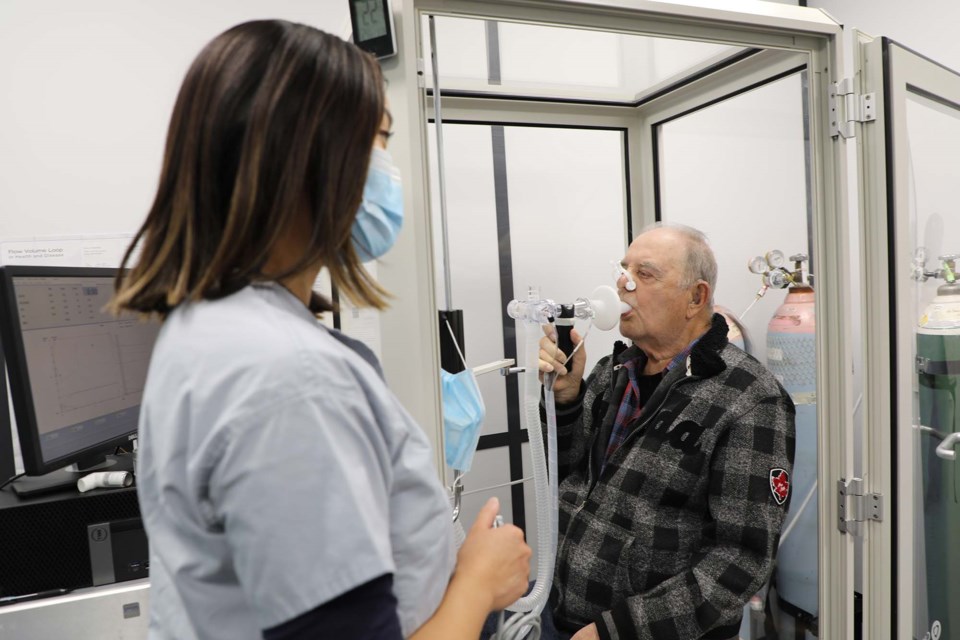Asthma presentation numbers at Sturgeon Community Hospital dropped dramatically last year compared to previous years.
“Overall, asthma has probably been a little bit better managed during the pandemic, for a few reasons,” said Dr. Alan Kaplan, family physician, chairperson of the Family Physician Airways Group of Canada, and a member of Asthma Canada’s medical and scientific advisory committee.
Kaplan and other health professionals said the low presentation of asthma in emergency departments during the pandemic can be attributed to everything from fear, medication compliance, lockdowns, and masking.
Numbers from Alberta Health Services show 195 people sought out hospital services for asthma at the Sturgeon Hospital for the fiscal year of April 1, 2020, to March 31, 2021; compared to 319 for the fiscal year of 2019 to 2020; and 290 for the fiscal year of 2018 to 2019.
Dr. Jaled Yehya owner of Alliance Respiratory Consultants in St. Albert said his clinic does everything from inpatient and consultations to emergencies.
He said although the AHS numbers focus primarily on the emergency department, he doesn’t expect those numbers are going to be much different than the numbers for acute-care clinics.
He said there are many reasons for last year's low numbers, and situations varied depending on the stage of the pandemic.
At the beginning of the pandemic, there was fear that those with lung conditions such as asthma faced a higher risk of a poorer outcome from COVID-19.
Patients were taking their medications regularly; they were religiously following recommendations.
“It's kind of an anxiety episode where, if they were not taking medications regularly, the outcome could be worse than if (they took) them regularly,” he explained.
Kaplan also believes fear is the main reason asthma was better managed during the pandemic.
“I think people were a little bit more afraid of the virus and therefore a little more adherent to their medications,” said Kaplan.
Yehya said the lower number of asthma presentations at hospitals is also due to avoidance of hospitals amid fears of being exposed to COVID.
Ss time passed, those numbers remained low.
“Patients with asthma start decreasing their exacerbations, or their flares, just because they continue to be compliant or adherent into therapy. But also, the respiratory infections decreased dramatically,” Yehya said.
According to the Government of Canada’s FluWatch report, there was no evidence of community circulation of influenza during the usual influenza season.
“Viral infections were dramatically zero during COVID-19. So, we start to see (patients) less, less, and less in the emergency department,” said Yehya.
The pediatric population also had a decreased amount of asthma incidences. Yehya doesn’t see too many pediatric patients, but he does see teachers and people who work in child-care settings.
Lockdowns and masking significantly prevented risk between infections, he said. Masking helped prevent respiratory infections throughout the pandemic, but masks also had the added bonus of protecting people from allergy triggers.
“Let's say if you have somebody who has an allergic component, let's say that you go into a mall and (it's) precipitated by perfumes or significant odours or some sort of exposure. So hopefully the mask minimizes some of those particles that get into your lungs and exacerbate some of your symptoms.
“So, we're assuming that that type of protection may help to control some of the symptoms,” Yehya explained.
Kaplan said distancing and masking tended to decrease the transmission of viruses, therefore making for fewer exacerbations.
“People weren't getting as bad with their asthma because they weren't having viral-infection triggers. Even for the inhalant’s triggers – things like grasses and trees and stuff – wearing a mask tends to filter some of that stuff out,” said Kaplan.
Both Yehya and Kaplan said one of the biggest things to come out of the pandemic was virtual care. Both used virtual care in their practices, and both have found benefits for themselves and their patients.
Yehya said he hopes people continue to be cautious about their health and continue to follow recommendations as we move out of the pandemic.
Kaplan has some recommendations for people with asthma as we move into the fall.
“Vaccination first of all (and) continue to wash hands. Until we're pretty sure, I think masks in group settings are probably going to still make sense. But that's going to probably be difficult to continue,” said Kaplan.



